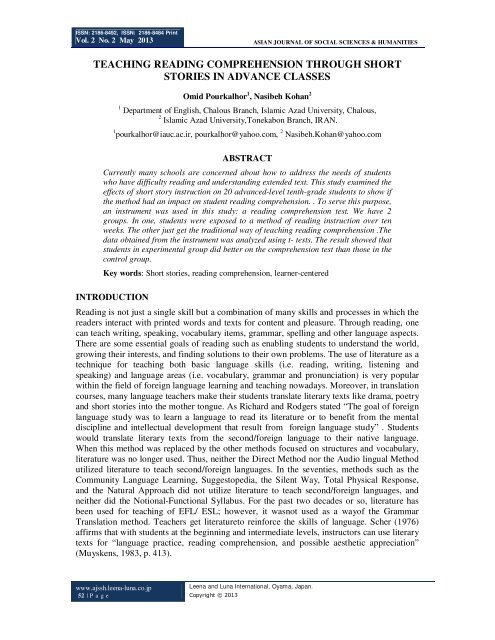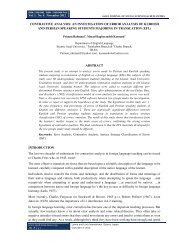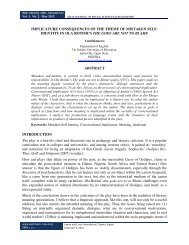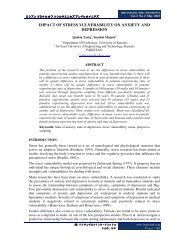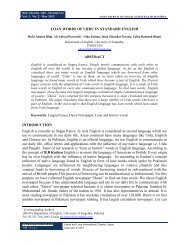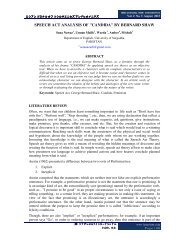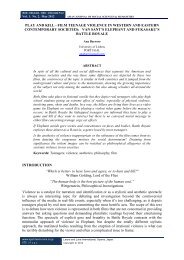Full Paper - Asian Journal of Social Sciences and Humanities (AJSSH)
Full Paper - Asian Journal of Social Sciences and Humanities (AJSSH)
Full Paper - Asian Journal of Social Sciences and Humanities (AJSSH)
Create successful ePaper yourself
Turn your PDF publications into a flip-book with our unique Google optimized e-Paper software.
ISSN: 2186-8492, ISSN: 2186-8484 Print<br />
Vol. 2 No. 2 May 2013<br />
ASIAN JOURNAL OF SOCIAL SCIENCES & HUMANITIES<br />
TEACHING READING COMPREHENSION THROUGH SHORT<br />
STORIES IN ADVANCE CLASSES<br />
Omid Pourkalhor 1 , Nasibeh Kohan 2<br />
1 Department <strong>of</strong> English, Chalous Branch, Islamic Azad University, Chalous,<br />
2 Islamic Azad University,Tonekabon Branch, IRAN.<br />
1 pourkalhor@iauc.ac.ir, pourkalhor@yahoo.com, 2 Nasibeh.Kohan@yahoo.com<br />
ABSTRACT<br />
Currently many schools are concerned about how to address the needs <strong>of</strong> students<br />
who have difficulty reading <strong>and</strong> underst<strong>and</strong>ing extended text. This study examined the<br />
effects <strong>of</strong> short story instruction on 20 advanced-level tenth-grade students to show if<br />
the method had an impact on student reading comprehension. . To serve this purpose,<br />
an instrument was used in this study: a reading comprehension test. We have 2<br />
groups. In one, students were exposed to a method <strong>of</strong> reading instruction over ten<br />
weeks. The other just get the traditional way <strong>of</strong> teaching reading comprehension .The<br />
data obtained from the instrument was analyzed using t- tests. The result showed that<br />
students in experimental group did better on the comprehension test than those in the<br />
control group.<br />
Key words: Short stories, reading comprehension, learner-centered<br />
INTRODUCTION<br />
Reading is not just a single skill but a combination <strong>of</strong> many skills <strong>and</strong> processes in which the<br />
readers interact with printed words <strong>and</strong> texts for content <strong>and</strong> pleasure. Through reading, one<br />
can teach writing, speaking, vocabulary items, grammar, spelling <strong>and</strong> other language aspects.<br />
There are some essential goals <strong>of</strong> reading such as enabling students to underst<strong>and</strong> the world,<br />
growing their interests, <strong>and</strong> finding solutions to their own problems. The use <strong>of</strong> literature as a<br />
technique for teaching both basic language skills (i.e. reading, writing, listening <strong>and</strong><br />
speaking) <strong>and</strong> language areas (i.e. vocabulary, grammar <strong>and</strong> pronunciation) is very popular<br />
within the field <strong>of</strong> foreign language learning <strong>and</strong> teaching nowadays. Moreover, in translation<br />
courses, many language teachers make their students translate literary texts like drama, poetry<br />
<strong>and</strong> short stories into the mother tongue. As Richard <strong>and</strong> Rodgers stated “The goal <strong>of</strong> foreign<br />
language study was to learn a language to read its literature or to benefit from the mental<br />
discipline <strong>and</strong> intellectual development that result from foreign language study” . Students<br />
would translate literary texts from the second/foreign language to their native language.<br />
When this method was replaced by the other methods focused on structures <strong>and</strong> vocabulary,<br />
literature was no longer used. Thus, neither the Direct Method nor the Audio lingual Method<br />
utilized literature to teach second/foreign languages. In the seventies, methods such as the<br />
Community Language Learning, Suggestopedia, the Silent Way, Total Physical Response,<br />
<strong>and</strong> the Natural Approach did not utilize literature to teach second/foreign languages, <strong>and</strong><br />
neither did the Notional-Functional Syllabus. For the past two decades or so, literature has<br />
been used for teaching <strong>of</strong> EFL/ ESL; however, it wasnot used as a way<strong>of</strong> the Grammar<br />
Translation method. Teachers get literatureto reinforce the skills <strong>of</strong> language. Scher (1976)<br />
affirms that with students at the beginning <strong>and</strong> intermediate levels, instructors can use literary<br />
texts for “language practice, reading comprehension, <strong>and</strong> possible aesthetic appreciation”<br />
(Muyskens, 1983, p. 413).<br />
www.ajssh.leena-luna.co.jp<br />
52 | P a g e<br />
Leena <strong>and</strong> Luna International, Oyama, Japan.<br />
Copyright © 2013
エシアン ゾロナル オフ ソシルサエニセズ アンドヒオメニテズ<br />
ISSN: 2186-8492, ISSN: 2186-8484 Print<br />
Vol. 2 No. 2 May 2013<br />
Many researchers <strong>and</strong> educators have made their attempts to find more efficient ways <strong>of</strong><br />
enabling the learners to become more pr<strong>of</strong>icient readers. Susan Louise Stern (1985), Yorio<br />
(1971), Mckinely (1974), Walsleben (1975), Gorman (1979), <strong>and</strong> Povey (1979) have all<br />
believed the effectiveness <strong>of</strong> the implementation <strong>of</strong> literature in the language class.<br />
So it can be seen that content knowledge is the most important factor in the learning process<br />
<strong>of</strong> reading comprehension. So for a good source <strong>of</strong> content knowledge itcan be mentioned<br />
literarytexts, <strong>and</strong> <strong>of</strong> course the short story. Using the short story toenhance students' reading<br />
pr<strong>of</strong>iciency has another advantage. Inthe short story, the readers tryto draw implications.<br />
Therefore, it makes students sensitive to the hidden <strong>and</strong> implied meaning. While in reading<br />
non-literary material students learn to read the lines <strong>and</strong> decode the meaning, in reading short<br />
stories they learn to read between the lines.<br />
REVIEW OF LITERATURE<br />
Reading Comprehension<br />
Comprehension occurs in the transaction between the reader <strong>and</strong> the text (Kucer, 2001;<br />
Rosenblatt, 1978). In reading comprehension, the reader is supposed to draw information<br />
from a text <strong>and</strong> then combine it with information he has (Celle- Murcia1996). Reading in<br />
second language is a complex <strong>and</strong> for reading comprehension learners must combine the<br />
skills to underst<strong>and</strong> the text. There is another definition according to Longman dictionary <strong>of</strong><br />
language teaching <strong>and</strong> applied linguistics as below:<br />
Different types <strong>of</strong> reading comprehension are <strong>of</strong>ten distinguished, according to the reader’s<br />
purposes in reading <strong>and</strong> the type <strong>of</strong> reading used. The following are commonly referred to:<br />
a. Literal comprehension: reading in order to underst<strong>and</strong>, remember, or recall<br />
the information explicitly contained in a passage.<br />
b. Informational comprehension: reading in order to find information which is<br />
not explicitly stated in a passage, using the reader’s experience <strong>and</strong> intuition<br />
<strong>and</strong> by inferring,<br />
c. Critical or evaluative comprehension: reading in order to compare<br />
information in a passage with the reader’s own knowledge <strong>and</strong> values.<br />
d. Appreciative comprehension: reading in order to gain an emotional or other<br />
kind <strong>of</strong> valued response from a passage. (p. 306)<br />
Chastain (1988) called reading is a receptive skill in that reader is receiving a message from a<br />
writer. The reading goal is to read for meaning or to recreate the writer’s meaning. Reading to<br />
improve pronunciation, practice grammatical forms, <strong>and</strong> study vocabulary do not constitute<br />
reading at all because reading involves comprehension. When readers do not comprehend,<br />
they are not reading (p. 217). Chastain in that book also mentioned “the ultimate goal <strong>of</strong><br />
reading comprehension must include other factors that convert a laborious problem-solving<br />
task in to viable skill. Language students have to learn to deal with linguistic material over<br />
which they have to control. They must learn to interact with the reading in productive fashion<br />
so as to determine meaning even when some <strong>of</strong> the words, ending, <strong>and</strong> patterns are not<br />
immediately meaningful. The goal is to reach a level at which they have confidence to<br />
overcome temporary or partial laps <strong>of</strong> underst<strong>and</strong>ing <strong>and</strong> to continue reading until they have<br />
understood the writer’s general meaning (p. 218)<br />
( 株 ) リ リ<br />
アンドル リ ル ル ル ル リ ル ル リ ル<br />
小 山 市 、 日 本 .<br />
www. leena-luna.co.jp<br />
P a g e | 53
ISSN: 2186-8492, ISSN: 2186-8484 Print<br />
Vol. 2 No. 2 May 2013<br />
ASIAN JOURNAL OF SOCIAL SCIENCES & HUMANITIES<br />
Benefit <strong>of</strong> Short Stories<br />
Some materials such as textbook are needed to enhance reading skills, such as word analysis,<br />
structural analysis, dictionary use, <strong>and</strong> learning the meaning <strong>of</strong> words from the context. Short<br />
stories could be beneficial since literature has the quality <strong>of</strong> being universal <strong>and</strong> short stories<br />
will allow the teacher to deal with human problem. Arigol (2001as cited in Hismanoglu, 2012<br />
in Khatib& Nasrollahi) listed the following advantages for pedagogical advantages <strong>of</strong> short<br />
stories over other literary texts:<br />
1. Short stories makes the students’ reading task easier because it is simple <strong>and</strong><br />
short Give learners a better view <strong>of</strong> other people <strong>and</strong> other cultures<br />
2. Requires more attention <strong>and</strong> analysis helps students to be more creative <strong>and</strong><br />
raise the critical thinking skills<br />
3. raise cultural awareness,<br />
4. reduce students anxiety <strong>and</strong> helps them feel more relax<br />
5. is good for multicultural contexts because <strong>of</strong> its universal language<br />
6. <strong>of</strong>fers a fictional <strong>and</strong> interesting world<br />
There are several benefits <strong>of</strong> short stories including motivational, cultural <strong>and</strong> higher-order<br />
thinking benefits. Nevertheless, before instructors look at these benefits in more details, they<br />
need to be reminded <strong>of</strong> one benefit that all instructors should take advantage <strong>of</strong>,<br />
reinforcement <strong>of</strong> skills (Odilea Rocha Erkaya ) . Instructors using short story in their classes,<br />
utilized all four skills to their learners.<br />
A great number <strong>of</strong> studies have discussed the benefits <strong>of</strong> using literature in language classes.<br />
For example Parkinson <strong>and</strong> Reid Thomas (2000, as cited in Sell, 2012 in Khatib& Nasrollahi)<br />
also made a list <strong>of</strong> ten reasons for using literature in the language classroom:<br />
1. Cultural enrichment<br />
2. Linguistic model<br />
3. Mental training<br />
4. Extension <strong>of</strong> linguistic competence<br />
5. Authenticity<br />
6. Memorability<br />
7. Rhythmic resource<br />
8. Motivating material<br />
9. Open to interpretation<br />
10. Convenience<br />
Maley (1989, as cited in Hismanoglu, 2005, 2012 in Khatib& Nasrollahi ) lists the following<br />
reasons for using literature in the language classroom:<br />
1. Universality<br />
2. Non-triviality<br />
3. Personal Relevance<br />
www.ajssh.leena-luna.co.jp<br />
54 | P a g e<br />
Leena <strong>and</strong> Luna International, Oyama, Japan.<br />
Copyright © 2013
エシアン ゾロナル オフ ソシルサエニセズ アンドヒオメニテズ<br />
ISSN: 2186-8492, ISSN: 2186-8484 Print<br />
Vol. 2 No. 2 May 2013<br />
4. Variety<br />
5. Interest<br />
6. Economy <strong>and</strong> Suggestive Power<br />
7. Ambiguity<br />
In their survey in Hong Kong, Lao <strong>and</strong> Krashen (2000) also found that the group who read<br />
literary texts had improvement in vocabulary <strong>and</strong> reading. Young (1996) discussed two<br />
advantages <strong>of</strong> using short stories for raising critical thinking in students as the following:<br />
"because they are entertaining, students' pervasive apprehension is reduced, <strong>and</strong> they learn<br />
from the beginning that critical thinking is natural, familiar, <strong>and</strong> sometimes even fun. Second,<br />
the stories put issues <strong>of</strong> critical thinking in an easily remembered context" (p. 90) (as cited in<br />
in Khatib& Nasrollahi, 2012). Murdoch (2002) indicates that “short stories can, if selected<br />
<strong>and</strong> exploited appropriately, provide quality text content which will greatly enhance ELT<br />
courses for learners at intermediate levels <strong>of</strong> pr<strong>of</strong>iciency” (p. 9). According to Erkaya (2005)<br />
short stories motivate students to continue reading so that they can solve the problem. And<br />
since it is interesting for students they would not easily get frustrated<br />
Purpose <strong>of</strong> the Study<br />
The purpose <strong>of</strong> this study is to stress on the effects <strong>of</strong> short stories over reading<br />
comprehension. Pr<strong>of</strong>icient readers do not read word by word to get the meaning, but they<br />
comprehend the text as a whole. Two main purposes are involved. The first one is to teach<br />
the student to enhance a particular attitude <strong>and</strong> to activate the student's knowledge through<br />
review what is known about the topic. It is also considered to check their own underst<strong>and</strong>ing,<br />
monitor their own reading comprehension, summarize the major ideas, paraphrase the text<br />
they have learnt, exp<strong>and</strong> on new ideas <strong>and</strong> words, <strong>and</strong> unite new information <strong>and</strong> previous<br />
one. Furthermore it is considered to help students not to translate the text word for word, train<br />
the students to identify the type <strong>of</strong> the text, get the main idea, <strong>and</strong> underst<strong>and</strong> title.<br />
RESEARCH QUESTIONS AND HYPOTHESES<br />
This question was mentioned in this survey:<br />
Is there any significant difference in reading comprehension through short stories or<br />
traditional way<br />
The null hypotheses <strong>of</strong> the study states that there is a significant relationship between these 2<br />
ways in teaching reading comprehension, <strong>and</strong> our group with teaching reading<br />
comprehension through short stories will get the best results in comprehension test.<br />
METHOD<br />
According to the hypothesis <strong>of</strong> this study, it is believed that learning English through short<br />
story would enhance reading comprehension. To examine the above research question the<br />
following corresponding null hypothesis was formulated:<br />
There is no significant difference between students' reading comprehension by teaching<br />
through short story or not in the advanced stages <strong>of</strong> language learning.<br />
Following experiment was designed to investigate the hypothesis:<br />
40 adult, Persian speaking advanced-level, in Kish institute, participated in this study. These<br />
students were all studying English as a foreign language, their ages ranged between 18to 24<br />
years. There were two groups <strong>of</strong> students: group A, <strong>and</strong> group B in their advanced level.<br />
( 株 ) リ リ<br />
アンドル リ ル ル ル ル リ ル ル リ ル<br />
小 山 市 、 日 本 .<br />
www. leena-luna.co.jp<br />
P a g e | 55
ISSN: 2186-8492, ISSN: 2186-8484 Print<br />
Vol. 2 No. 2 May 2013<br />
ASIAN JOURNAL OF SOCIAL SCIENCES & HUMANITIES<br />
Instrument<br />
In each group that is, group A <strong>and</strong> B there were 20 students. An identical Pre-tests which<br />
consists <strong>of</strong> selected reading passage from different TOEFL books were given to both groups.<br />
Students <strong>of</strong> group A (the experimental group) were taught the book "Modern Short Stories in<br />
English " by Robert J. Dixson. The book is a collection <strong>of</strong> simple short stories. The materials<br />
used for the control group were selected from different reading books, internet, magazine,<br />
etc. At the end <strong>of</strong> the semester both groups were given an identical Post-Tests which consists<br />
<strong>of</strong> five selected reading passages from different TOEFL books.<br />
Procedures<br />
A group <strong>of</strong> 40 students in Advanced level has been sampled for the purpose <strong>of</strong> this study. The<br />
students were then divided into two groups – the control group <strong>and</strong> the experimental group.<br />
Both the groups were administered an identical Pre-Test which showed a uniformity in the<br />
results with very little variation that shows the two groups are have similar reading ability.<br />
Both the groups were instructed by one <strong>of</strong> the researcher for a full semester in the reading<br />
courses designed for them. The materials used for the control group were selected from<br />
different reading books, internet, magazine, etc. <strong>and</strong> the experimental group was using short<br />
stories. At the end <strong>of</strong> the semester both groups were given an identical Post-Tests which<br />
consists <strong>of</strong> five selected reading passage from different TOEFL books.<br />
DATA ANALYSIS AND RESULTS<br />
In order to test the research question that whether using short stories can enrich Iranian EFL<br />
learners' reading ability an independent t-test was run to compare the mean scores <strong>of</strong> the two<br />
groups on the posttest. In order to probe the effect <strong>of</strong> short stories on the improvement <strong>of</strong> the<br />
reading ability <strong>of</strong> the students an independent t-test is run to compare the mean scores <strong>of</strong> the<br />
two groups on the posttest <strong>of</strong> reading. The t-observed value is 4.693 (Table 1). This amount<br />
<strong>of</strong> t-value is higher than the critical value <strong>of</strong> 2.02 at 40 degrees <strong>of</strong> freedom.<br />
Table 1. Independent T-Test Posttest <strong>of</strong> Reading Comprehension by Groups<br />
Independent Samples Test<br />
reading Equal<br />
variances<br />
assumed<br />
Equal<br />
variances<br />
not<br />
assumed<br />
Levene's Test<br />
for Equality <strong>of</strong><br />
Variances t-test for Equality <strong>of</strong> Means<br />
F Sig. t df<br />
Sig.<br />
(2-<br />
tailed)<br />
Mean<br />
Difference<br />
95% Confidence<br />
Interval <strong>of</strong> the<br />
Difference<br />
Std. Error<br />
Difference Lower Upper<br />
19.098 .000 4.693 38 .000 4.05000 .86291 2.30314 5.79686<br />
4.693 27.490 .000 4.05000 .86291 2.28094 5.81906<br />
Based on these results it can be concluded that there is a significant difference between the<br />
mean scores <strong>of</strong> the experimental <strong>and</strong> control groups' on the posttest <strong>of</strong> reading<br />
www.ajssh.leena-luna.co.jp<br />
56 | P a g e<br />
Leena <strong>and</strong> Luna International, Oyama, Japan.<br />
Copyright © 2013
エシアン ゾロナル オフ ソシルサエニセズ アンドヒオメニテズ<br />
ISSN: 2186-8492, ISSN: 2186-8484 Print<br />
Vol. 2 No. 2 May 2013<br />
comprehension.Thus the null-hypothesis as using short stories cannot enrich Iranian EFL<br />
learners' reading ability is rejected. Table 2 displays the mean scores for the experimental (M<br />
= 17.0000) <strong>and</strong> control (M = 12.9500) groups on the pretest <strong>of</strong> reading.<br />
Group Statistics<br />
Table 2: Descriptive Statistics Posttest <strong>of</strong> Reading<br />
reading<br />
Std.<br />
short story N Mean Std. Deviation Mean<br />
+shortstory<br />
20 17.0000 1.68585 .37697<br />
-shortstory<br />
20 12.9500 3.47131 .77621<br />
Error<br />
Following graph displays the mean scores <strong>of</strong> the two groups on the posttest <strong>of</strong> reading:<br />
Graph: Posttest <strong>of</strong> Reading by Groups<br />
The experimental <strong>and</strong> control groups enjoy homogenous variances on the posttest <strong>of</strong> reading.<br />
As displayed in Table 1, the probability associated with the Levene's F <strong>of</strong> 19.098 is 38. Since<br />
the probability is higher than the significance level <strong>of</strong> .05, it can be concluded that the<br />
experimental <strong>and</strong> control groups enjoy homogenous variances. That is why the first row <strong>of</strong><br />
Table 2 "Equal variances assumed" is reported.<br />
( 株 ) リ リ<br />
アンドル リ ル ル ル ル リ ル ル リ ル<br />
小 山 市 、 日 本 .<br />
www. leena-luna.co.jp<br />
P a g e | 57
ISSN: 2186-8492, ISSN: 2186-8484 Print<br />
Vol. 2 No. 2 May 2013<br />
ASIAN JOURNAL OF SOCIAL SCIENCES & HUMANITIES<br />
CONCLUSION<br />
The ability to underst<strong>and</strong> a text is based not only on the reader’s linguistic knowledge, but<br />
also on general knowledge <strong>of</strong> the world <strong>and</strong> the extent to which that knowledge is activated<br />
during processing. The results <strong>of</strong> all ESL/EFL studies <strong>and</strong> the view <strong>of</strong> reading comprehension<br />
as an interactive process between the reader <strong>and</strong> the text [44] lead to several implications for<br />
the teachers. Many experts support use <strong>of</strong> literature in foreign language teaching, but it can be<br />
seen that literary texts in language classes are not without problem. Hismanoglu (2005) found<br />
this problem that: “First, there are very few pedagogically-designed appropriate materials that<br />
can be used by language teachers in a language classroom. Second, there is a lack <strong>of</strong><br />
preparation in the area <strong>of</strong> literature teaching in TESL/TEFL programs. Third, there is the<br />
absence <strong>of</strong> clear-cut objectives defining the role <strong>of</strong> literature in ESL /EFL. Many instructors<br />
try to include literature in their classroom, but there is lack the background <strong>and</strong> training in<br />
that field” (p.65).<br />
This study found that all respondents in a group that the researchers thought reading<br />
comprehension through short story showed improvement after the reading course <strong>and</strong> the<br />
result <strong>of</strong> the present study shows that the control group <strong>and</strong> experimental group show a<br />
significant difference in their posttest.<br />
The results <strong>of</strong> the research found sufficient reasons for teaching short story in Iranian reading<br />
comprehension classroom. However since the size <strong>of</strong> the sample was small, the results cannot<br />
be generalized to all Iranian context. Other variables such as the cultural <strong>and</strong> educational<br />
background, gender, age <strong>of</strong> the students can affect the findings <strong>of</strong> this study. Further research<br />
is recommended to validate the findings <strong>of</strong> the current study.<br />
www.ajssh.leena-luna.co.jp<br />
58 | P a g e<br />
Leena <strong>and</strong> Luna International, Oyama, Japan.<br />
Copyright © 2013
エシアン ゾロナル オフ ソシルサエニセズ アンドヒオメニテズ<br />
ISSN: 2186-8492, ISSN: 2186-8484 Print<br />
Vol. 2 No. 2 May 2013<br />
REFERENCE<br />
Alptekin, C. (2006). Cultural familiarity in inferential <strong>and</strong> literal comprehension in L2<br />
reading.System, 34(4), 494–508.<br />
Anderson, N. J. (1994). Developing active readers: A pedagogical framework for the second<br />
language reading class.System, 22(2), 177-194.<br />
Bernhardt, E. B. &Kamil, M. L. (1995). Interpreting relationships between L1 <strong>and</strong> L2<br />
reading: Consolidating the linguistic threshold <strong>and</strong> the linguistic interdependence<br />
hypotheses. Applied Linguistics, 16, 15–34.<br />
Best, J.W. & Kahn, J.V. (2006). Research in Education (10th ed.) New York: Pearson<br />
Education Inc.<br />
Celce-Murcia, M., Dörnyei, Z. &Thurrell, S. (1995). Communicative competence: A<br />
pedagogically motivated model with content specifications. Issues in Applied<br />
Linguistics 6, 5-35.<br />
Chastain, K. (1988). Developing Second Language Skills (3rd ed.).Chicago: Harcourt Brace<br />
Jovanovich.<br />
Chiang, M. (2007). Improved reading attitudes <strong>and</strong> enhanced English reading comprehension<br />
via literature circles. Lagos <strong>Paper</strong>s in English Studies, 1(1), 168-183.<br />
Cubukcu, D. (2008). Enhancing vocabulary development <strong>and</strong> reading comprehension through<br />
metacognitive strategies. Issues in Educational Research, 18(1), 1-11.<br />
Dahmardeh, M. (2009).Communicative textbooks: English language textbooks in Iranian<br />
secondary school. Linguistik online 40, 4/09, 45-61.<br />
Erkaya, O. R. (2005). Benefits <strong>of</strong> using short stories in the EFL context.<strong>Asian</strong> EFL <strong>Journal</strong>, 8,<br />
38-49.<br />
Guo, Y. & Roehring, A. D. (2011). Roles <strong>of</strong> general versus second language (L2) knowledge<br />
in L2 reading comprehension. Reading in a Foreign Language, 23(1), 42–64.<br />
Haji Maibodi, A. (2008). Learning English through short stories.Iranian <strong>Journal</strong> <strong>of</strong> Language<br />
Studies, 2(1), 41-72.<br />
Hismanoglu, M. (2005). Teaching English through literature. <strong>Journal</strong> <strong>of</strong> Language <strong>and</strong><br />
Linguistic Studies, 1(1), 53-66.<br />
Krashen, S. D. (1982). Principles <strong>and</strong> practice in second language acquisition. New York:<br />
Prentice-Hall.<br />
Layton, A., Robinson, J. & Lawson, M. (1998). The relationship between syntactic awareness<br />
<strong>and</strong> reading performance. <strong>Journal</strong> <strong>of</strong> Research in Reading, 21, 5–23.<br />
Lao, C. Y., &Krashen, S. (2000).The impact <strong>of</strong> popular literature study on literacy<br />
development in EFL: More evidence for the power <strong>of</strong> reading. System, 28(2), 261-<br />
270.<br />
McKay, S. (2001). Literature as content for ESL/EFL.In M. Celce-Murcia (Ed.), Teaching<br />
English as a second or foreign Language (pp. 319-322). Boston, MA: Heinle&Heinle.<br />
Murdoch, G. (2002). Exploiting well-known short stories for language skills development.<br />
IATEFL LCS SIG Newsletter 23, 9-17.<br />
( 株 ) リ リ<br />
アンドル リ ル ル ル ル リ ル ル リ ル<br />
小 山 市 、 日 本 .<br />
www. leena-luna.co.jp<br />
P a g e | 59
ISSN: 2186-8492, ISSN: 2186-8484 Print<br />
Vol. 2 No. 2 May 2013<br />
ASIAN JOURNAL OF SOCIAL SCIENCES & HUMANITIES<br />
Premawardhena, N. G. (2005). Integrating literature into foreign language teaching: A Sri<br />
Lankan perspective. Novitas-ROYAL, 1(2), 92-97.<br />
Pressley, M., Brown, R., El-Dinary, P. & Afflerbach, P. (1995). The comprehension<br />
instruction that students need: Instruction fostering constructively responsive reading.<br />
Learning Disabilities Research & Practice, 10(4), 215-224.<br />
Qian, D. D. (1999). Assessing the roles <strong>of</strong> depth <strong>and</strong> breadth <strong>of</strong> vocabulary knowledge in<br />
reading comprehension. Canadian Modern Language Review, 56, 282–307.<br />
Qian, D. D. (2002). Investigating the relationship between vocabulary knowledge <strong>and</strong><br />
academic reading performance: An assessment perspective.Language Learning, 52,<br />
513–536.<br />
Sen, S. H. (2009).The relationship between the use <strong>of</strong> metacognitive strategies <strong>and</strong> reading<br />
comprehension. Procedia <strong>Social</strong> <strong>and</strong> Behavioral <strong>Sciences</strong>, 1, 2301–2305<br />
Sell, J. P.A. (2005). Why teach literature in the foreign language classroom Encuentro,<br />
15(1), 86-93.<br />
Stern, S. L. (2001). An integrated approach to literature in ESL/EFL.In Celce-Murcia (Ed.),<br />
Teaching English as a second or foreign Language (pp. 328-345). Boston, MA:<br />
Heinle&Heinle.<br />
Uso-Juan, E. & Martinez-Flor, A. (2006). Towards acquiring communicative competence<br />
through reading. In E. Uso-Juan, & A. Martinez-Flor (Eds.), Current trends in the<br />
development <strong>and</strong> teaching <strong>of</strong> the four language skills (pp. 261-279). Berlin: Mouton<br />
de Gruyter.<br />
Williams, E. (2006). Teaching reading: Individual <strong>and</strong> social perspectives. In E. Uso-Juan, &<br />
A. Martinez-Flor (Eds.), Current trends in the development <strong>and</strong> teaching <strong>of</strong> the four<br />
language skills (pp. 355-383). Berlin: Mouton de Gruyter.<br />
Young, A. (1996). Introducing critical thinking at the college level with children’s stories.<br />
College Teaching, 44(3), 90-93.<br />
www.ajssh.leena-luna.co.jp<br />
60 | P a g e<br />
Leena <strong>and</strong> Luna International, Oyama, Japan.<br />
Copyright © 2013


